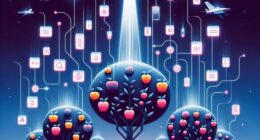Exploring the Limits of AI in Language-Based Puzzles
In the quest to understand the full capabilities of artificial intelligence (AI), researchers from the NYU Tandon School of Engineering have taken an innovative approach by testing AI’s ability to solve the New York Times’ intricate Connections puzzle. This daily challenge presents a fascinating arena for examining the intersection between AI and human linguistic intuition.
The Connections puzzle tasks players with categorizing 16 seemingly unrelated words into four sets based on thematic links. These connections range from straightforward associations to more abstract relationships that require creative thinking to decipher.
AI vs. The New York Times’ Linguistic Challenge
In anticipation of the IEEE 2024 Conference on Games, set to take place in Milan, Italy, the researchers’ study offers insights into how modern natural language processing (NLP) systems handle language-based puzzles. This work, detailed on the arXiv preprint server, underscores the significant strides made in AI language understanding and raises intriguing questions about the technology’s current limitations.
Julian Togelius, the study’s guiding force, is an Associate Professor of Computer Science and Engineering (CSE) at NYU Tandon and the Director of the Game Innovation Lab. Under his direction, the research team explored the potential of leading-edge AI, specifically focusing on two approaches: the utilization of cutting-edge Large Language Models (LLMs) like GPT-3.5 and GPT-4 from OpenAI, and the implementation of sentence embedding models (BERT, RoBERTa, MPNet, MiniLM) to parse and understand complex semantic information.
Breaking Down the Findings
The research revealed that while AI systems, particularly GPT-4, could solve a portion of the Connections puzzles, achieving a full grasp on the game remains a formidable challenge. GPT-4 led the pack by successfully solving about 29% of the puzzles, showcasing a superior understanding of language nuances compared to its predecessors and other models. However, aligning AI performance with human capabilities, especially in solving the most “tricky” puzzles, is still a work in progress.
Graham Todd, a Ph.D. student at the Game Innovation Lab and the study’s lead author, highlighted the importance of understanding where AI struggles in semantic processing through the lens of the Connections puzzle.
The team also experimented with enhancing GPT-4’s effectiveness using “chain-of-thought” prompting, a method that encourages the model to process information in a more structured manner. This technique improved GPT-4’s puzzle-solving success rate to over 39%, emphasizing the potential benefits of guiding AI through reasoning steps.
Pushing the Boundaries of AI and Creativity
Aside from evaluating AI’s puzzle-solving prowess, the researchers are intrigued by the possibility of using advanced models like GPT-4 to craft novel word puzzles. This exploration into the creative domains signifies a leap towards understanding how AI can transcend traditional computational tasks to engage in genuine creative processes.
The datasets for these experiments comprised 250 puzzles, reflecting the diverse range of challenges offered by the Connections game between June 12, 2023, and February 16, 2024. The study not only benchmarks AI’s current capabilities but also paves the way for future explorations into enhancing AI’s understanding and manipulation of language.
Alongside Togelius, Todd, and Timothy Merino, another Ph.D. student at the Game Innovation Lab, Sam Earle contributed to the research efforts. Their work continues to build upon Togelius’ extensive research in applying AI to gaming and exploring how games can, in turn, advance artificial intelligence.
This fascinating study underscores the evolving relationship between AI and language, offering a glimpse into the future of AI capabilities, and poses thrilling possibilities for the integration of AI in creative and intellectual human endeavors.










